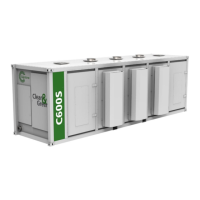Capstone Turbine Corporation • 16640 Stagg Street • Van Nuys • CA 91406 • USA
Installation Guide: Capstone C1000S/C800S/C600S with C1000 Series Controller
480064 Rev C (December 2018) Page 58 of 122
Capstone reserves the right to change or modify, without notice, the design, specifications, and/or contents of this document without
incurring any obligation either with respect to equipment previously sold or in the process of construction.
6.1.1. Shutoff Valve
An inlet shutoff valve is installed to lock out the fuel delivery system and microturbine from the
fuel source. This can be any type of valve that provides a vapor tight seal and that is compatible
with the fuel components. In some cases, this may be an automated valve, which will fail closed
in the event of a system shutdown or failure.
6.1.2. Sediment Trap
Capstone recommends that a sediment trap or filter be placed at the beginning of the fuel
conditioning system. This filter will eliminate any large particles or contaminants from the site’s
pretreatment system and piping. Make sure to provide for adequate drainage and disposal of any
condensate and sediments or solids captured by this trap.
6.1.3. Compressor Filter
If a flame arrestor or compressor is installed, it may be necessary to install an inlet filter to protect
these components from liquid-borne debris. Common filter types include coalescing, mesh-pad,
cyclonic, or baffled separators. Take care to select the appropriate filter type and size for the
application. In many cases, using a coalescing filter may be sufficient to both remove liquid phase
condensate and provide additional filtration. Filters that are collecting liquid must be drained into
an appropriate condensate removal system. The approach will differ from one site to another,
depending on ambient temperatures, fuel type, moisture content, existing fuel treatment, etc.
6.1.4. Third Party Compressor
When sizing a compressor, consider the pressure or suction at the compressor inlet and consider
the pressure drop across the system in order to determine the maximum pressure required at the
compressor outlet.
For low pressure natural gas (LPNG) systems, Capstone provides an integrated Fuel Gas Booster
(FGB). For additional information on the FGB, please refer to the C1000S/C800S/C600S
Technical Reference (Table 1).
6.1.5. Microturbine Filter
Particulate and coalescing filtration is required for each microturbine fuel inlet per the Capstone
MicroTurbine Fuel Requirements Technical Reference (Table 1), the O&I drawings, and the P&ID
drawings.
Filters should be inspected once a week during the first month of operation. If the filter has
construction debris, clean or replace the filter. If the filters are wet, then the gas does not meet
dew point suppression requirements. If this occurs, immediate corrective action must be taken,
as this impacts performance of the microturbine and the warranty may be voided if damage to
fuel system components or engine is caused by fuel moisture. Following corrective action, replace
filter elements, and continue checking once a week for several weeks to verify that the filters
remain dry.
6.1.6. Condensate Drain
A condensate drain is a device for removing liquid and contaminants from the filter. If a
condensate drain is not installed, or the drain is not operating properly, oil and/or water will collect,
affecting the filter efficiency. Refer to Section 6.5.3 for details.

